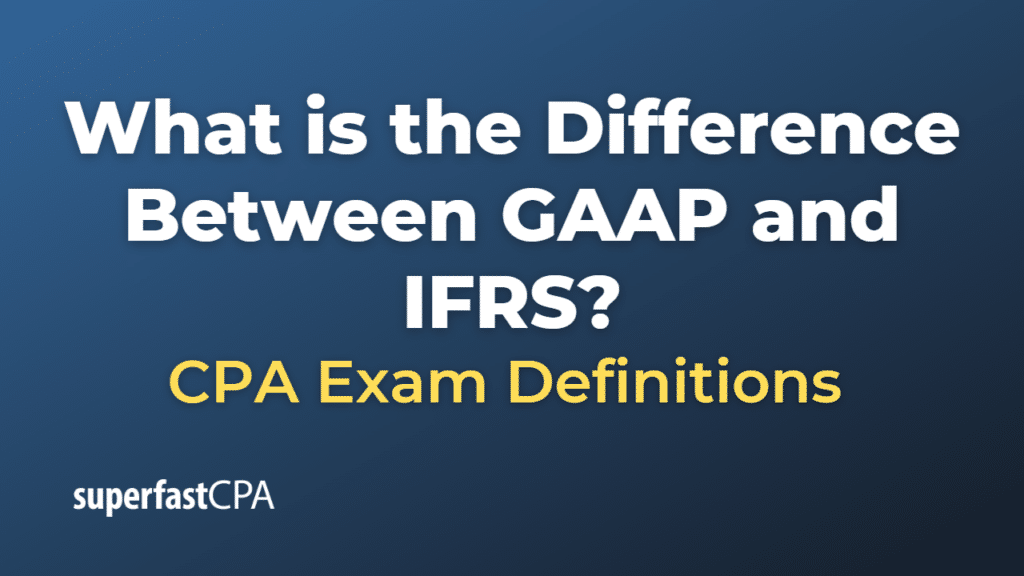Difference Between GAAP and IFRS
GAAP (Generally Accepted Accounting Principles) and IFRS (International Financial Reporting Standards) are two sets of accounting standards that companies use to prepare their financial statements. These standards guide how transactions and other accounting events are recognized, measured, presented, and disclosed in financial reports.
GAAP
GAAP is primarily used in the United States. It is issued by the Financial Accounting Standards Board (FASB), a private-sector organization. GAAP is known for being rules-based, meaning it provides specific, detailed instructions for many accounting scenarios. Some argue that this approach leaves less room for interpretation, but it can also result in complexity and make it harder to apply the standards to new or unique situations.
IFRS
IFRS is used in more than 140 countries worldwide, including in the European Union. It is issued by the International Accounting Standards Board (IASB), an independent, private-sector body. IFRS is more principles-based, meaning it provides broad guidelines that can be applied to a wide variety of situations. Some argue that this approach provides more flexibility and better allows for judgment in reflecting the economic substance of transactions, but it can also result in less comparability across companies.
Key Differences
While GAAP and IFRS have many similarities, there are also several key differences between them, including:
- Inventory costing: GAAP allows the use of the Last In, First Out (LIFO) method for inventory costing, while IFRS does not.
- Reversal of inventory write-downs: GAAP prohibits the reversal of inventory write-downs, while IFRS allows it if specific criteria are met.
- Component depreciation: While both GAAP and IFRS allow for the depreciation of property, plant, and equipment components separately, IFRS strongly encourages it, but under GAAP, this practice is less common.
- Intangible assets: GAAP and IFRS have different criteria for recognizing and measuring intangible assets like research and development costs.
- Presentation of financial statements: The formats for presenting financial statements also vary under GAAP and IFRS.
It’s important to note that the goal of both GAAP and IFRS is to provide accurate, transparent, and consistent financial information to investors and other stakeholders. There is also an ongoing effort to converge the two sets of standards to improve comparability and consistency across different jurisdictions.
Example of the Difference Between GAAP and IFRS
Let’s provide a few examples of how GAAP and IFRS could lead to different reporting outcomes:
Example 1: Inventory Costing
Consider a manufacturing company that has a significant amount of inventory.
Under GAAP, the company could choose to use the Last In, First Out (LIFO) method of inventory valuation. If the cost of acquiring inventory has been increasing, LIFO would result in a higher cost of goods sold and a lower net income compared to the First In, First Out (FIFO) method, because the most recently acquired (and more expensive) items are considered sold first.
However, under IFRS, the LIFO method is not allowed. The company would have to use another method like FIFO or weighted average cost, which could result in a lower cost of goods sold and a higher net income if inventory costs have been rising.
Example 2: Reversal of Inventory Write-downs
Now, imagine that the same manufacturing company had to write down the value of its inventory due to obsolescence. Later, the market conditions change, and the value of the inventory recovers.
Under GAAP, the company is not allowed to reverse the inventory write-down. The write-down would have led to a loss when it was recognized, and the subsequent recovery in value would not affect the company’s financial statements.
However, under IFRS, if the conditions that caused the inventory to be written down are no longer present, the company can reverse the write-down. This would result in a gain recognized in the period of the reversal, increasing the company’s net income.
Example 3: Intangible Assets
Lastly, consider a tech company that incurs significant research and development (R&D) costs.
Under GAAP, most R&D costs are expensed as incurred, which decreases net income. Only when the product has been proven to be commercially viable can subsequent costs be capitalized.
Under IFRS, R&D costs are divided into a research phase and a development phase. Costs in the research phase are expensed as incurred, similar to GAAP. However, once a project has moved into the development phase, which is typically when commercial viability has been assessed, the costs can be capitalized, which may result in higher net income compared to GAAP.
These examples demonstrate how using GAAP or IFRS can lead to different financial results, making it important for users of financial statements to understand the accounting standards used by the company.













